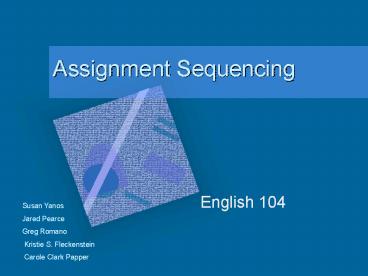Assignment Sequencing - PowerPoint PPT Presentation
1 / 18
Title:
Assignment Sequencing
Description:
In James Moffet's ideal curriculum, students actively participate in ... past (history, narration) formal. reporting. what happens. present perception. informal ... – PowerPoint PPT presentation
Number of Views:19
Avg rating:3.0/5.0
Title: Assignment Sequencing
1
Assignment Sequencing
- English 104
Susan Yanos Jared Pearce Greg Romano Kristie S.
Fleckenstein Carole Clark Papper
2
Possible Alternatives
- Cognitive Development Model
- Social Action Model
3
Cognitive Development
- Loosely based on work of James Moffet
- Both the assignments and the demands placed on
the student as writer increase in complexity.
4
Moffet, briefly . . .
- In James Moffets ideal curriculum, students
actively participate in their own learning, using
language in functional, realistic ways, to
explore and write about the worlds they
inhabit. - Ideally, students progress in abstraction (and
their assignments increase in difficulty), as
they move along a communication continuum from I
--gtYou --gt It.
5
Moffet, briefly
- I --gtYou --gt It means that as the writer
develops, she progress from I--gtI communication
(e.g., reflection) to I--gt You (f2f conversation,
written correspondence, more abstract
correspondence directed to an unknown audience)
and finally to I--gtIt. - I--gtIt communication is characterized by both
increased abstraction in thinking/writing and
increased distance between writer and
reader/audience.
6
Cognitive Development Four Action Stages
7
Cognitive Development Recording
- Time frame-- 2 weeks
- 1. Observe
- Physical
- On-site, both setting and behaviors
- 15 minutes
- Make careful notes
- Textual
- Explore an assigned text
- Follow the set time limit
- Make careful notes
- 2. Record
- Focus on 3 different audiences
- Roommates, instructor, police
- Absent classmate, instructor, parent
- Select details accordingly
8
Cognitive Development Reporting What Happened
- Time Frame -- 4-5 weeks
- fieldwork (choose different audiences)
- textual (choose different audiences)
- 2 reports (formal compositions)
- Visual--multiple media option (website)
- The key here is beginning to to recognize the
movement away from self (I) addressing the needs
of an audience (You) toward other (It).
9
Cognitive Development Generalizing
- Time Frame -- 4-5 weeks
- Analysis of patterns in body of data
- From body of data, evolve generalization about
that body of data, - Formal research project (incorporate conventions
of academic research writing)
10
Cognitive Development Theorizing
- Time Frame -- 4 weeks
- Incorporate all the stages
- Recording, reporting, generalization
- From body of data evolve a theory about what will
happen - Speculate about causes
- Infer future theory
- Predict future trends
11
Options for Finals
- Visual presentation on the project
- Compose a timed writing prompt growing out of
project and write the essay in response to it
12
Social Action Model
- Research and Change
- not a course in writing about specific issues
rather a course in - researching something students want to change and
then - composing in order to address that need to change
and how to effect change
13
Social Action Model
- Multiple Rhetorical Situations/Audiences
- Academic
- Indifferent
- Hostile
- Community
14
Social Action Model
- Academic --
- Addressing the demands of the academic situation
- Begins with advocating for change (research
paper) - Explore situations needing change
- Address multiple academic audiences
- Incorporate formal style, appropriate sources
incorporation
15
Social Action Model
- Moving beyond the traditional academic audience,
we need to consider the elements of the
rhetorical situation in terms of three
alternative audiences - Hostile
- Indifferent
- Community
16
Social Action Model
- Explore alternate ways of persuasion(e.g.,
narrative as persuasion) - Develop different approaches to/emphases on the
trilateral relationship - Employ different approaches to/emphases on the
trilateral relationship - Enter community
- Determine nature of audience
- Develop approach based on students own analysis
17
Social Action
- Community (composed of academic, indifferent and
hostile audiences) - Enter community
- Determine nature of audience
- Develop approach based on students own analysis
18
Social Action
- Begin with Academic Context (the research paper
on a given topic) to complete the progress of
summary?synthesis?analysis - Move from this to different rhetorical situations
in order to meet the demands of the other 3
essays

